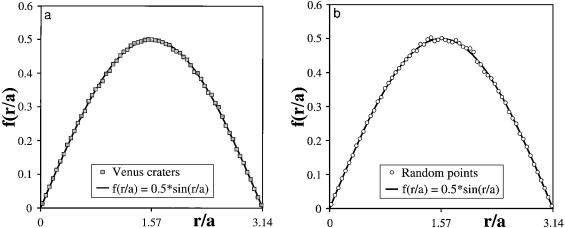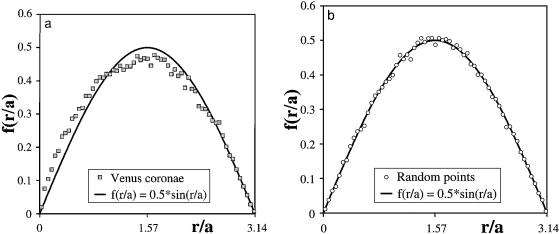

Icarus 139, 49–54 (1999)
Article ID icar.1999.6084, available online at http://www.idealibrary.com on
Catastrophic Resurfacing and Episodic Subduction on Venus
D. L. Turcotte, G. Morein, D. Roberts, and B. D. Malamud
Department of Geological Sciences, Cornell University, Ithaca, New York 14853-1504
E-mail: turcotte@geology.cornell.edu
Received March 3, 1998; revised September 4, 1998
There is clear evidence that a catastrophic resurfacing event occurred on Venus in the relatively recent past. A primary data source for this resurfacing event is the spatial distribution of impact craters. In this paper, we apply the pair-correlation technique to the observed crater distribution and find that the result is identical to that for a random distribution. In order to test the sensitivity of the technique, we also apply it to the spatial distribution of coronae on Venus. For the coronae, we find substantial deviations from a random distribution. One explanation for the catastrophic resurfacing is the episodic subduction hypothesis. We model episodic subduction using a thermal boundary-layer stability analysis. We find that episodic subduction events with intervals of 500 to 700 Myr can transport only 15–25% of the radiogenic heat produced within the planet. We suggest that the remainder of the heat must be lost to the surface during a period of vigorous tectonic activity, following the subduction event but prior to the subsequent stabilization of a global lithosphere. c 1999 Academic Press
Key Words: Venus; tectonics; cratering; heat flow; mantle convection.
INTRODUCTION
One of the most important results of the Magellan mission to Venus was the information provided on the tectonic evolution of the planet. Two major conclusions are now generally accepted:
(1)Venus does not have plate tectonics as we know it on Earth. There is no evidence for a global pattern of accretional plate margins and subduction zones.
(2)The age of the surface of Venus is nearly uniform and is neither very old (heavily cratered) nor very young (very lightly cratered).
Other observed features of the venusian surface also provide important insights into the global tectonic evolution of the planet. It is necessary to explain the regions of elevated topography and the coronae. There does not appear to be any analogs to coronae on Earth.
The essential question in understanding the tectonic evolution of Venus is to understand how it loses heat. Based on our knowledge of Earth, it is reasonable to conclude that this loss of heat would be associated with the instability and subduction of the
lithosphere. However, without plate tectonics, how does subduction occur? Turcotte (1993, 1995) proposed that episodic global subduction events occur on Venus. Parmentier and Hess (1992) associate episodic subduction with a chemical instability of the lithosphere. An alternative hypothesis is that Venus had active plate tectonics like Earth during its early evolution, but that the global lithosphere subsequently stabilized and Venus is now in a transient state between plate tectonics (Earth) and lithospheric conduction (Mars) (Arkani-Hamed and Toksoz 1984, ArkaniHamed et al. 1993, Arkani-Hamed 1994).
It is expected that Venus will have concentrations of the heatproducing elements uranium, thorium, and potassium, similar to the concentrations found in Earth. If the heat generated by those elements is to be lost at the surface, then either the heat must be conducted through a stable lithosphere or the lithosphere must be subject to episodic subduction. The alternative is that the temperature within the planet is increasing. In the long term, such heating must lead to some kind of a catastrophic event.
On Earth, the internal radiogenic heating generates mantle convection. Earth’s lithosphere is the cold thermal boundary layer associated with this convection. The thermal instability of the lithosphere leads to its subduction at ocean trenches and its continuous replacement at ocean ridges. This is plate tectonics. The cooling of Earth’s interior due to the subducted cold lithosphere constitutes some 70% of the heat transfer out of the mantle. The remainder can be attributed to delamination (partial subduction) of the lithosphere and to hot mantle plumes that are associated with the instability of a hot thermal boundary layer at depth.
In this paper, we address two aspects of the tectonic evolution of Venus: first, we consider whether the distribution of craters on Venus is random, and second, we consider a simple parameterized convection model for episodic subduction. Cratering statistics are the primary data base for establishing the age distribution of the venusian surface. Although it is well established that a catastrophic resurfacing event occurred, the time progression of resurfacing has been open to considerable debate. We apply the pair-correlation technique to the spatial distribution of craters on Venus in order to quantify the randomness of the distribution.
We also consider a simple parameterized model for episodic convection on Venus. This model is based on boundary-layer
49
0019-1035/99 $30.00 Copyright c 1999 by Academic Press All rights of reproduction in any form reserved.

50 |
TURCOTTE ET AL. |
stability criteria for a thickening thermal lithosphere. The temporal evolution of the mantle temperature and viscosity and the thickness of the lithosphere are determined.
CRATERING STATISTICS
The hypothesis of a global resurfacing event on Venus is largely based on the distribution of impact craters over the surface of the planet. On both the Moon and Mars, ancient surfaces are clearly differentiated from younger surfaces by large differences in crater densities. The earliest results from Magellan indicated that this was not the case for Venus. The density of craters over the surface of Venus appeared to be essentially uniform and this led to the hypothesis of a global resurfacing event (Schaber et al. 1992).
It is clearly desirable to quantify just how uniform the distribution of craters over the surface of Venus is. In order to do this, Strom et al. (1994) carried out Monte-Carlo simulations in which totally random distributions of craters were obtained. The actual distribution of craters could not be visually distinguished from the random simulations. In this paper, we wish to systematically quantify the randomness of the crater distribution on Venus. A standard approach to this problem is to obtain paircorrelation statistics (Kagan and Knopoff 1980, Turcotte 1997). In this method, the distance from each crater to all other craters is determined. We assume Venus to be a sphere so that the range of distances between craters is from r D 0 to r D ºa, where a is the radius of the planet. The length r is measured along the surface of the sphere. The probability distribution function, f (r=a), for these distances is then obtained.
Before proceeding with Venus, we obtain the results we would expect for a random distribution of points (craters) over the surface of a sphere. In order to do this, we pick one point and con-
sider the distribution of other points as a function of the distance r from the point chosen. In the immediate vicinity of the chosen point, the number of adjacent random points will increase in proportion to r , the maximum number of random points will be at r=a D º/2, and the number of random points will approach zero as r=a ! º. The increment of area at a distance r from the chosen point is 2ºa2 sin µ dµ where dµ D dr=a. Thus, the expected probability distribution function for points randomly distributed over the surface of Venus is
f (r=a) D 0:5 sin(r=a): |
(1) |
The probability distribution function for the pair-correlation statistics of random points on a sphere is a sine function.
We have obtained the pair-correlation statistics for 923 craters on Venus using data from Herrick et al. (1997). Because of the very large number of pair-correlation data points, º106, the data are binned with bin width 1r=a D 0:05. The binned data corresponding to the probability distribution function f (r=a) are given in Fig. 1a. We compare this to the analytical prediction given in (1). As a measure of agreement we use the Pearson product moment correlation coefficient, r , which is a dimensionless index that ranges for °1.0 to 1.0 and reflects the extent of a linear relationship between two data sets. For the data shown in Fig. 1a we have r 2 D 0:9996. In order to further test the agreement of the crater statistics with a random distribution we obtain the paircorrelation statistics for 923 points randomly distributed over a sphere, the resulting binned data are given in Fig. 1b. Again, we compare the random simulation data with the analytical prediction given in (1). In this case r 2 D 0:9994. The crater data are essentially indistinguishable from the random data. In addition, both the crater data and the random data coincide very closely with the analytic relation given in (1). In fact the crater data with
FIG. 1. (a) Pair-correlation technique applied to 923 craters on Venus. The probability distribution function for distances between craters, f (r=a), is given as a function of (r=a). (b) Pair-correlation technique applied to 923 points randomly distributed over a sphere. The probability distribution function for distances between points, f (r=a), is given as a function of (r=a). In both cases, the data are compared with the analytical prediction for a random distribution given in (1). For the Venus craters we find r 2 D 0:9996 and for the 923 random points we find r 2 D 0:9994.

CATASTROPHIC RESURFACING AND EPISODIC SUBDUCTION ON VENUS |
51 |
r 2 D 0:9996 are slightly closer to the analytic relation (1) then the random simulation with r 2 D 0:9994.
Although the results given in Fig. 1 indicate no significant differences between the distribution of craters and a random distribution, it is also of interest to determine how sensitive the pair-correlation technique is to deviations. In order to provide a comparative test we consider the pair-correlation statistics for the distributions of coronae on Venus. Using nearest-neighbor statistics, Squyres et al. (1993) concluded that the spatial distribution of coronae on Venus is fractal rather than random. The spatial distribution of hostspots on Earth is also fractal (Jurdy and Stefanick 1990). Both the coronae on Venus and the hotspots on Earth are clustered relative to a random distribution. Because of this clustering, we would expect that the pair-correlation statistics for the coronae would deviate significantly from random simulations. We have obtained the pair-correlation statistics for 335 coronae on Venus; the results for the binned probability distribution function f (r=a) are given in Fig. 2a. Again, the pair-correlation statistics are compared with the analytical prediction given in (1). For the data shown in Fig. 2a we have r 2 D 0:9690. This relatively low value quantifies the obvious differences between the coronae data and the random prediction
(1). Once again, we make a direct comparison with a random simulation. The pair-correlation statistics for 335 points randomly distributed over sphere are given in Fig. 2b. Again the data are compared with the analytical prediction given in (1), in this case r 2 D 0:9971. This value is somewhat lower than the r 2 D 0:9994 for the random simulation given in Fig. 1b, the increased scatter in Fig. 2b can be attributed to the smaller number of random points considered. However, the random simulation is much closer to the analytical prediction than the coronae data.
There are several significant differences between the data given in Figs. 1a and 2a. First, there is considerably more scat-
ter for the pair-correlation statistics of coronae than for craters. This can be attributed to the smaller number of coronae considered. Even with this scatter, it is clear from Fig. 2 that there are significant differences between the coronae data and the random data. For small separations, (r=a) < 1, the coronae data lie systematically above the random data. For larger separations, 1 < (r=a) < 2:5, the coronae data lie systematically below the random data.
When data are clustered, small separations of points are dominant over large separations. Thus, the pair-correlation statistics for coronae given in Fig. 2 are consistent with clustering relative to a random distribution. If there were significant variations in age over the surface of Venus then there would also be significant variations in crater densities relative to a random distribution. This is clustering. Thus, significant variations in the age of the surface of Venus over significant areas would be expected to give large values of f (r=a) for small r=a. There is no evidence for this clustering in the pair-correlation statistics for venutian craters given in Fig. 1. Thus, we conclude that the pair-correlation data confirm the previous conclusion that the spatial distribution of craters on Venus is indistinguishable from a random distribution.
IMPLICATIONS OF CRATERING STATISTICS
There is conclusive evidence for a “catastrophic” resurfacing event on Venus. There are no “heavily cratered” regions on Venus. Thus, there is no evidence for “old” lithosphere on Venus as there is on Earth in the continental cratons. Since there must have been lithosphere on Venus at all times in the past, the evidence is that this lithosphere was “destroyed” either by subduction or by extensive internal deformation.
FIG. 2. (a) Pair-correlation technique applied to 335 coronae on Venus. The probability distribution function for distances between craters, f (r=a), is given as a function of (r=a). (b) Pair-correlation technique applied to 335 points randomly distributed over sphere. The probability distribution function for distances between points, f (r=a), is given as a function of (r=a). In both cases the data are compared with the analytical prediction for a random distribution given in (1). For the Venus Coronae we find r 2 D 0:9690 and for the 335 random points we find r 2 D 0:9971.

52 |
TURCOTTE ET AL. |
Although we can say conclusively that the surface of Venus has been resurfaced in the relatively recent past, say 500 Ma, the temporal history of the resurfacing is open to question. Uncertainties in the absolute cratering record for Venus lead to uncertainties in the age of the surface. It is probably reasonable to say that the resurfacing was centered at 500 ß 200 Ma. Physically, the resurfacing must have spanned some length of time, it certainly did not occur instantaneously.
A number of authors have examined the surface evidence for the temporal distribution of volcanism on Venus (Bullock et al. 1993, Herrick 1994, Namiki and Solomon 1994, Price and Suppe 1994). Various estimates have been given for the age distribution of the Venus surface. Because the results are sensitive to the assumed areal distribution of more recent volcanic flows, it is very difficult to provide quantitative constraints on the age history of the surface of Venus. We will present two hypothetical end-member models for the surface age distribution: a fast resurfacing model and a slow resurfacing model.
For the fast resurfacing model, we assume that the oldest surface is 600 Ma. We further assume that 90% of the surface was resurfaced in 10 Myr and 98% of the surface was resurfaced in 50 Myr. For the slow resurfacing model, we again assume that the oldest surface is 600 Ma. We assume that 70% of the surface was resurfaced in 30 Myr, 90% in 100 Myr, and 98% in 300 Myr. From a tectonic prospective, the principal differences between the two end-member models is the role of continuing volcanic and tectonic processes versus the creation of the new lithosphere to replace old lithosphere.
EPISODIC SUBDUCTION MODEL
If it is accepted that episodic global subduction of the lithosphere on Venus is the primary mechanism for heat loss, it is clearly desirable to quantify the mechanism. In order to do this, we consider a parameterized boundary-layer model for high Rayleigh number thermal convection. This model was proposed by Howard (1966) for turbulent thermal convection. In this model it is assumed that the upper thermal boundary layer (the lithosphere) becomes unstable and sinks (subducts) when the Rayleigh number based on the thickness of the lithosphere YL reaches a critical value Racr. We hypothesize that a global subduction event occurs when
Ra |
cr D |
m gÆ[Tm(t ) ° Ts]YL3 |
; |
(2) |
|
¥(t ) |
|||||
|
|
|
where m D 4500 kg m°3 is the average mantle density, g D 8:6 m s°2 is the surface gravity on Venus, Æ D 2:4 £ 10°5 K°1 is the thermal expansion coefficient, Ts(t ) is the mean mantle temperature, Ts D 750 K is the surface temperature, and D 10°6 m2 s°1 is the thermal diffusivity. The mantle viscosity ¥(t ) is itself a strong function of the mantle temperature,
E a
¥(t ) D C e RTm (t ) ;
with constant C D 1:414 £ 104 Pa s, activation energy Ea D 5:23 £ 105 J mol°1, and gas constant R D 8:31 J mol°1 K°1.
After a global subduction event there are two important effects that increase the Rayleigh number. The first is the increase in the thickness of the lithosphere YL in time; the second is the decrease in mantle viscosity ¥(t ) as the interior mantle temperature Tm increases. The Rayleigh number of the lithosphere increases until it reaches the critical value, Racr, and another global subduction event occurs.
We assume that Venus has the same rate of radiogenic heat production per unit mass, H (t ), as Earth. We further assume that the heat production within Venus can be approximated by (Turcotte and Schubert 1982, p. 332)
H (t ) D H0e° (t °t0 ); |
(4) |
where H0 D 6:18 £ 10°12 W kg°1 is the present heat production, t0 is the age of Earth, t is time measured forward, andD 2:77 £ 10°10 year°1. We assume that between global subduction events the radiogenic heat production heats the mantle and write
C |
dTm(t ) |
D H (t ); |
(5) |
dt |
where C is the specific heat. The solution of (4) and (5) is
Tm(t ) D Tm(ts) C |
H0e t0 |
°e° ts ° e° t ¢; |
(6) |
C |
where ts is the time of the last subduction event. The corresponding thickness of the lithosphere is given by (Turcotte and Schubert 1982, p. 164)
YL(t ) D 2:32[ (t ° ts)]1/2: |
(7) |
Solutions of (3), (6), and (7) give the dependence on time of the mantle temperature Tm, mantle viscosity ¥(t ), and the lithospheric thickness YL(t ) between subduction events.
In order to complete the formulation of the problem we must specify the heat loss from the mantle during a subduction event. We assume that this is made up of two parts: The first part is due to the subduction of cold lithosphere and the second part is the loss of heat to the surface before a new global lithosphere stabilizes. Under these assumptions, the change in the mantle temperature due to a global subduction event, 1Tm, is given by
|
D |
pº |
£m |
|
v ° |
L |
§ ° |
|
|
||
1Tm |
|
(Tm(t ) ° Ts) l |
Rv3 ° (Rv ° YL)3 |
|
1T ; |
(8) |
|||||
|
1:16 |
|
|
|
(R |
|
Y )3 |
|
|||
|
|
|
|
|
|
|
|
||||

CATASTROPHIC RESURFACING AND EPISODIC SUBDUCTION ON VENUS |
53 |
FIG. 3. Values of the mantle temperature in Venus, Tm, as a function of |
FIG. 4. Values of the mantle viscosity, ¥, as a function of time t , with |
time, t . Results are given for prescribed temperature losses 1T D 25 and 100 K. |
1T D 100 K. |
In order to solve this problem an initial mantle temperature for the planet is assumed, Tm D Tm0 at t D 0. Equations (3), (6), and (7) are solved numerically to give Tm(t ); ¥(t ), and YL(t ); these values are then substituted into the stability criteria (2) until it is satisfied. When it is satisfied a global subduction event is assumed to have occurred. The change in the mantle temperature due to the subduction event is determined from (8) and the process is repeated. After a few subduction events, the thermal evolution of the mantle is insensitive to the initial mantle temperature Tm0.
A number of simulations have been carried out using the numerical values given above and various values of the heat loss parameter 1T . Values of the mantle temperature in Venus, Tm as a function of time t , are given in Fig. 3, with 1T D 25 and 100 K. With 1T D 25 K, global subduction events occur at intervals of about 150 Myr. This is clearly not consistent with our understanding of Venus. However, it is consistent with plate tectonics on Earth. For Earth it is appropriate to take 1T D 0, and our analysis would predict that subduction would occur at intervals of about 125 Myr. This is close to the average age of subducting lithosphere on Earth.
In order to get longer intervals between global subduction events it is necessary to increase 1T . With 1T D 100 K we find the intervals to be about 500 Myr as shown in Fig. 3. Thus, approximately 75% of the heat loss from the interior of Venus must occur after a global subduction event and prior to the establishment of a new global lithosphere. The values of mantle viscosity and lithosphere thickness in this simulation are given in Figs. 4 and 5. The mantle viscosity oscillates between values of about 1022 and 1024 Pa. This two orders of magnitude decrease in the mantle viscosity during the mantle heating phase contributes substantially to the instability of the lithosphere, leading to a global subduction event. The lithosphere thickness increases to a value YL º 250 km prior to subduction.
It should be emphasized that the parameterized boundarylayer model is highly idealized. An alternative approach would
be to consider full numerical models of thermal convection. Solomatov and Moresi (1996, 1997) have carried out numerical calculations of thermal convection within Venus, including both a strong temperature dependence and a nonlinear rheology. Because of the strong temperature dependence, a stagnant lid (rigid global lithosphere) is found under a wide range of parameter values. A basic question is whether the fluid approach can reasonably model the subduction of a lithosphere with a strongly temperature-dependent rheology. Since our primary purpose is to model the subduction of a thickening thermal lithosphere, the boundary-layer instability approach seems to be appropriate. The fact that it successfully predicts the age of subducting lithosphere on Earth is a verification of the approach. A principal result of our analysis is that the subduction of a global lithosphere on Venus at intervals of 500 Myr or more can only transport a small fraction of the heat being generated within the
FIG. 5. Values of the lithospheric thickness, YL, as a function of time t , with 1T D 100 K.
